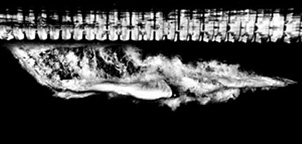CARLILE COACHES' FORUM
Produced, edited, and copyrighted by
Professor Brent S. Rushall, San Diego State University
Volume 6, Number 1: January 1, 2000

BASIC PRINCIPLES UNDERLYING RACING DIVES
Dives are important in racing. There have been introductions of spurious features of racing dives over the past 20 years. Most of them contribute to poorer starts.
A high dive will make a swimmer go deeper upon entry and therefore, the swimmer will cover more vertical distance to get to the surface. Covering that extra distance costs time. Dives that feature kicks in the air, piking at the hips, and all other movements do not affect the path of the center of gravity. All they usually do is make the entry less efficient. Once a swimmer is in the air the trajectory of the center of gravity is set and cannot be changed by any body movements.
The features of a "proper dive" are as follows.
- Before the feet leave the blocks, the swimmer should be stretched straight (fully extended) so the center of gravity is as far as possible from the block. A spear-like position should be achieved by placing as much emphasis as possible on streamlining in the air. This should produce the longest dive.
- The entry into the water should be as far away from the blocks as possible. This should be one of the principal aims of the dive.
- The entry should be with as little splash as possible (the arms should bore a hole in the water and the rest of the body should go through that hole). This will minimize the frontal resistance as well as reduce wave resistance produced by the swimmer. The bigger the splash, the worse the dive because energy will be used to move water rather than propel the swimmer through the water.
- The entry angle should be such that it allows the greatest horizontal distance to be covered at the fastest speed. While other swimmers might be going deep and then having to come up to the surface, a good swimmer should be optimizing travel towards the other end of the pool.
- Follow any dive in crawl stroke with from 3-6 of the fastest possible double-leg kicks. The arms, head, and torso should be stationary while doing these kicks. The kicking action should start below the torso. The face should look down so that the top of the head bores forward even though it is between the upper arms.
- Avoid sudden changes of the trajectory path underwater. Rising to the surface should follow a smooth and gradual path. While following the trajectory curve, it is helpful to curve the body to align with the path rather than holding it rigidly straight.
- Time surfacing with when the velocity of the dive declines and reaches swimming velocity. Most swimmers, and in particular breaststrokers, stay under water too long. Other than in breaststroke, arm stroking should begin before a breath is taken.
- A good dive will have minimal bubbles dragged underwater. The greater the amount of bubbles, the greater is the drag/resistance on the swimmer.
A simple dive that will help a swimmer to get to 15 m fastest will be the best dive.
Following is a picture of an Olympic finalist underwater after a dive. The resistance created by her physical features and a sudden change in direction can be seen by the bubbles and drag turbulence that follows her. This is not a good follow-through.

What is the best foot placement on the blocks? A recent study has shown that a track start is better than a grab start (Juergens, Rose, Smith, & Calder, 1999). Previous research has not been definitive on this topic because swimmers are best at the start they have practiced most (Gambrel, Blanke, Thigpen, & Mellion, 1991). When teaching new or developing swimmers to start, the track start is preferred to the double-leg or "grab" start. If a swimmer wants to change from a grab start, introduce the track start as soon as possible and practice it more than usual so that it will become the dominant movement pattern for starting.
Reference
- Gambrel, D. W., Blanke, D., Thigpen, K., & Mellion, M. B. (1991). A biomechanical comparison of two relay starts in swimming. Journal of Swimming Research, 7, 5-9.
- Juergens, C. A., Rose, D. J., Smith, G. A., & Calder, C. A. (1999). A kinetic and kinematic comparison of the grab and track starts in competitive swimming. Medicine and Science in Sports and Exercise, 31(5), Supplement abstract 616.
Return to Table of Contents for Carlile Coaches' Forum.




